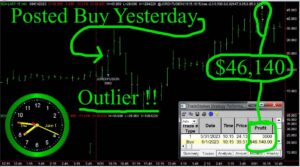Beyond Day Trading: An Insight Into Intraday Stock Trading
Understanding Intraday Stock Trading

Intraday Stock Trading is often misunderstood as synonymous with day trading, but they are not the same. To comprehend the essence of Intraday Stock Trading, we first need to define certain terms. Conventionally, “day trading” refers to buying and selling a stock within the same trading day. Day traders often carry extensive positions to leverage small price movements into substantial profits. The key ingredients for a day trader’s success are high liquidity and market volatility, with the latter measured by the daily range – the larger the range, the greater the potential profit or loss.
The Value of Intraday Stock Data
About three decades ago, I found myself intrigued by intraday data. However, it was not to develop day trading systems but to construct strategies for short-term stock trading. Intraday data transformed into an invaluable tool, enabling the creation of two and three-day trading systems that were far more sophisticated than previously possible.
Intraday Trading: Beyond Day Trading
Upon hearing the phrase “Intraday Stock Trading,” most traders envision day trading. Personally, I’ve never been drawn to day trading. The systems I developed, although marginally profitable for day trading, consistently performed better when trades were held for an additional day or two.
The Past Allure of Day Trading

There was a time when day trading held some appeal, mainly because brokers allowed day traders to handle more significant positions with less capital. The rationale was simple: less risk was involved if no trades were held overnight. Thus, a trader with limited funds could still manage a sizable position as long as they liquidated all positions by the end of the day. The key takeaway here was that a day trader could leverage their positions more than a position trader could.
The Aftermath of the 2008 Crash
Unfortunately, the allure of day trading dimmed after the 2008 crash. Day traders, often wrongly blamed for the stock market meltdowns of the early 21st century, were likened to the perceived communists of the 1950s. While day traders played no role in those market crashes, government institutions, often misunderstanding the dynamics of market behavior, nonetheless introduced numerous restrictions to curb day trading.
The Changing Landscape Post-Crash

The primary restriction introduced post-2008 crash mandates “pattern day traders” to maintain trading accounts of at least $25,000. If a “pattern day trader’s” account dips below this amount, the law requires it to be closed. This rule, quite frankly, is nonsensical and does not answer the crucial question: “How could individuals with less than $25,000 to trade have triggered a worldwide meltdown of nearly all equity markets in 2008?” Yet, day traders were the “little guys” with negligible political influence, making them convenient scapegoats for the government.
Fast forward to 2023, and there’s no compelling reason to day trade. Today’s day trading environment requires more capital investment for lesser returns. While the pattern day trading rule didn’t impact me significantly as I’m not a day trader, I had to eliminate most of my day of entry stops to avoid being flagged as one. Surprisingly, this move didn’t affect the performance of my two and three-day short-term trading systems. For more on trading without stops, refer to my article, “Stop Loss Order”.
The Value of Intraday Trading in Short-Term Trading
So, why am I, a non-day trader, interested in intraday stock trading? The answer lies in the ability intraday data provides to better manage my positions over a two or three-day period. To understand this, let’s explore one general observation about markets.
Markets are predominantly random – an assertion I’ve made repeatedly. However, it’s also noteworthy that markets tend to exhibit more randomness at the beginning of the day, and less towards the end.
Harnessing this observation necessitates examining intraday data and strategizing entries and exits based on different timeframes. My trading system, JORDI FUSION indeed uses two timeframes – daily bars AND 15-minute bars.
Intraday data, particularly 15-minute bars, are crucial to my trading system, even as a non-day trader. Just how crucial these 15 minute bars can be can be seen in one spectacular trade we took on Thursday, June 1, 2023 in the stock, Sun Car Technology Group:
(click to enlarge)

Look at this chart and you can see two data streams: the 15 minute bars are on top and the daily bars are below. Now look carefully and you can see that we got out of this trade on the high bar of the day with huge profits of over 46 thousand dollars. But looking closely at these first seven 15 minute bars of the day you can see something else: The prices for the first hour or so fluctuate wildly. For example if we had exited this trade on the first bar of the day and on the low, we would have only realized about 17 thousand dollars in profits, not the 46 thousand dollars we actually took out of this trade. And furthermore if we had waited less than 30 minutes from our actual exit time our profits would have been under fifteen thousand dollars. Trading off those 15 minute intraday bars made all the difference in executing this spectacular trade. I’ve programmed JORDI FUSION to take profits at the right time using those 15 minute intraday bars and on June 1, 2023 it got out perfectly, on the high bar of the day!
Time Stops Versus Price Stops

If you’ve read my article, “Stop Loss Order”, you’d know that I favor TIME STOPS over PRICE STOPS. While Price stops are solely price-dependent, my time stops combine price AND time, necessitating intraday stock data for calculations. Using only price stops could have prematurely ended my positions at the most unfavorable time.
By incorporating time into my stops, I evaded the erratic price swings at market opening and locked in a $24,000 profit about an hour later, when the markets were far less volatile. My intraday trading systems are unique, merging two data streams – daily AND 15-minute bars, enabling a vastly superior trading strategy that allows trades to extend beyond a single day.
The Key Takeaway
The essential point I wish to underscore here is that Intraday Stock Trading is NOT equivalent to day trading. While I am a short-term stock trader, I am NOT a day trader. Even as I hold positions for up to three days, I AM an Intraday Stock Trader, and my JORDI FUSION algorithm continuously monitors 15 minute bars throughout the market day. And Using intraday data in this manner gives me an enormous advantage over most other traders.
